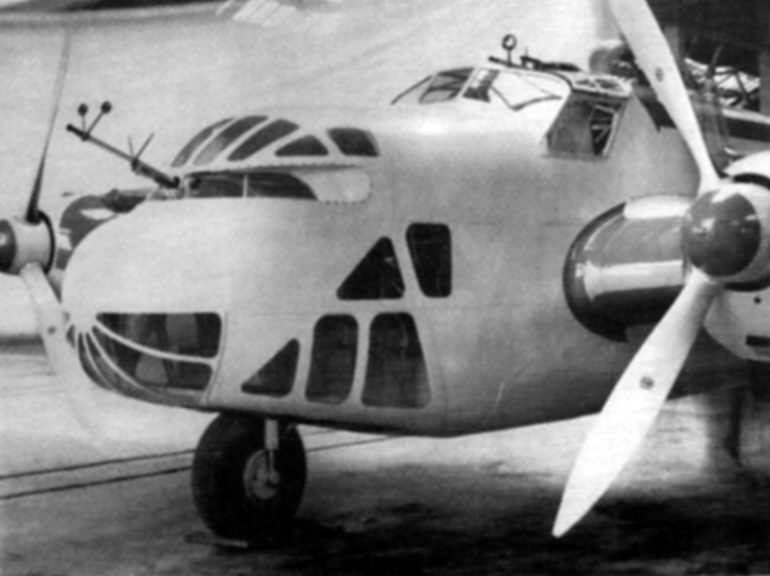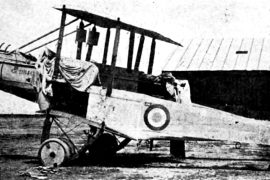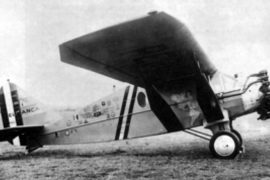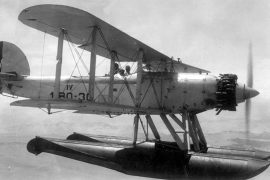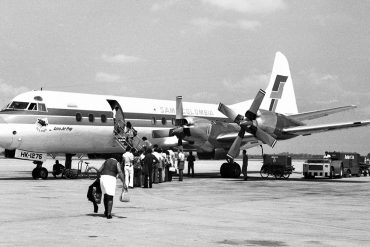The subject of speculation, conjecture and considerable mis-information for years, the little known Caproni Ca. 135s built and exported to Peru for use by the nation’s Cuerpo de Aeronáutica -CAP- (Peruvian Air Corps) have taken on, more recently, an air of mystery, due in no small part to their brief meteoric appearance and disappearance from Peruvian service.
Described, even in allied literature, as “Basically a sound design,” the Ca. 135 was the first truly modern aircraft to emanate from the Caproni Aeronáutica Bergamasca firm. Although it suffered from underpower in its initial versions, and was built in only comparatively small numbers, the type was exported to the Hungarian Air Force and to Peru, and saw active combat service with both. Italy, for its own part, only evinced a modest interest in the type, and concentrated, instead, on primarily tri-motor designs for its medium bomber forces.
The evolution of the Ca. 135 can probably be attributed to the influence of Ing. Cesare Pallavicino, who joined Caproni after leaving the Breda firm in 1933. Until then, Caproni had been fielding a rather conventional series of mainly training biplanes but, with his arrival, soon moved to newer designs, incorporating cantilever monoplane wing arrangements, retractable landing gear, variable-pitch props and rudder and aileron trim devices.
The Ca. 135 was designed during the summer of 1934 and, consequently, may be viewed as a contemporary of the U.S. Douglas B-18 and the British Vickers Wellington, although it was dimensionally smaller than both. Like the American and English designs, it owed its creation to an official government specification asking for a medium bomber of twin-engine design capable of carrying a 2,650 pound bomb load over a range of at least 620 miles at a maximum speed of not less than 240 mph at 16,400 feet. The aircraft also had to be able to maintain that altitude on one engine.

The first flight of the Ca. 135 was on April 1, 1935 and, with a normal crew complement of four, together with full radio and photographic equipment, the aircraft as it evolved, was to be armed with three Breda-designed turrets. One of these was to be placed rather oddly under a tortoise-shell like prominence on the upper nose, between the bombardier/navigator’s position and the pilot’s cockpit, while the second was in the dorsal area immediately behind the cockpit. The third, in the Peruvian aircraft, was a ventral hatch gun position of uncertain characteristics. Each of these could accommodate either two 7.7mm machine guns (with 500 rounds per gun) or one 12.7mm gun (with 300 rounds per gun) and the bomb load was variable with either two 1,760lb. weapons, two 1,100 lbs, four 550 lbs, twelve 220 or 110 lbs bombs or twelve 44 lbs incendiary devices. With Italian flight testing completed around May 1936, the Italian Regia Aeronáutica ordered 14 examples for further evaluation.
While these events were taking place in Europe, the Argentine Army and Navy were just starting to consider the acquisition of what they believed at the time to be one of the most modern, twin-engine medium bombers available: the Martin 139WAA and 139WAN, export derivatives of the B-10. The first of these weren’t delivered until 1937 and 1938, however. These long-serving aircraft are often cited as the first “Truly modern” monoplane medium bombers to serve in Latin America. In fact, that honor belongs to the Peruvian Ca. 135s.
In Peru, the mid-1930s saw the emergence of the politcal party Alianza Popular Revolucionaria Americana or APRA of Haya de la Torre, which transformed Peruvian society and had a consequent effect upon Peru’s armed forces. One of the avowed objectives of APRA was to “Internationalize the Panama Canal” which was, significantly as we will see, only 1,200 air miles from the most forward Peruvian operating base at Chiclayo. The Aprista-led uprising of July 1932, followed in short order by the border incident with Colombia known as the Leticia Incident, and the advent of the moderate dictatorship of General Oscar Raimundo Benavides, set the stage for the modernization of the Peruvian armed forces, which had turned in a rather mediocre showing against the Colombians in the Leticia region, especially the CAP.
The urgency of the need to modernize and re-train the CAP led to a fascinating period of Peruvian aviation history which saw, between 1930 and 1941, official aviation missions in the country from France, Great Britain, Italy and the United States, in turn, all striving to convince the CAP that the equipment and training syllabus of each nation was best for Peruvian requirements. So unusual was this competition that, by 1934, the CAP had effectively divided itself into four operating sections, each with an instructor of foreign nationality, as follows:
| Section 1 | Primary Training | Captain Álvares | Cuerpo de Aeronáutica del Perú |
| Section 2 | Fighter & Aerobatics | Captain Luigi Bianchi | Royal Italian Air Force |
| Section 3 | Bombers, Armament and Navigation | Captain H.M. Pearson | Royal British Air Force |
| Section 4 | Army Cooperation & Reconnaissance | Donald Kessler | U.S. Civilian |
Of these foreign instructors, Captain Luigi Bianchi is of particular note for the purpose of this narrative. Bianchi was, at the time, seconded to the Caproni firm in Italy for the express purpose of serving as test pilot for the array of Caproni aircraft being acquired, or to be acquired, for the CAP. These included 12 Caproni Ca. 100 primary Trainers, which arrived circa June 1934 (with approximately 13 more to be “built” in Peru), 12 Ca. 111 bomber/transports (the first delivered in October 1934) a single Ca. 113 aerobatics/advanced trainer (delivered in June 1934) and 12 Ca. 114 fighters, which arrived commencing in January 1935.
The four sections of this international training team was mounted on an equally cosmopolitan array of aircraft Section 1 had four Morane-Saulnier MS 315s, Section 2 had Caproni Ca. 114s (and the solitary Ca. 113), Section 3 had Potez 39A-2s, a Curtiss Falcon and Hanriot H-438s, and Section 4 had a miscellaneous assortment of Curtiss Falcons, Vought Corsairs and Hanriot H-438s! The solitary operational CAP unit at the time was at Chiclayo, about 350 miles North of Lima, and was mounted entirely on the new Caproni Ca. 111s outfitted as bombers.
The Ca. 111s were, in the words of CAP personnel of the time, “Ugly and underpowered“, but, nonetheless, were the sole aircraft in the CAP inventory that could, at least in theory, reach targets in Colombia -which of course would involve an overflight of neighboring Ecuador, which was powerless at the time to intercede.
The CAP also had a small, float-equipped unit of assorted Vought Corsair variants and Curtiss Hawk IIs at Iquitos, to protect that vital river port from Colombian attack. The CAP also possessed an incredible menagerie of other virtually new aircraft at the time, but many of these were in storage and had not even been erected. They included six Fairey Fox IIs, six Fairey Seals (often cited as Gordons) and at least six (and possibly as many as 12) Nieuport-Delange NiD-123 fighters and a large collection of light and medium transport types.
It did not take the Peruvians long to realize that operating such a heterogeneous collection of aircraft was fraught with a multitude of problems. Some of the aircraft they acquired in haste, in anticipation of a protracted war with Colombia, lacked the performance necessary to operate in anything but the most low-altitude areas of the nation. Since Peru perceived her primary threats as originating in Colombia or neighboring Ecuador, and in view of the acquisition of twin and tri-motored bomber aircraft (Bellanca 77-140 and Junkers Ju-52/3Ms) capable of reaching Peruvian cities from Colombia, the already well-established Caproni interests in Peru lobbied intensively for the acquisition of a stable of light and medium bomber aircraft to specifically match and counter the Colombian acquisitions. Thus entered the Ca. 310 and Ca. 135.
The 14 Ca. 135s acquired by Italy were known as the Tipo Spagna, because they ultimately saw service during the Spanish Civil War with the Italian contingent there. Compared with the original prototype, however, these were equipped with 836hp Asso XI R.C. Engines (later modified to deliver up to 900hp at 13,120ft.)
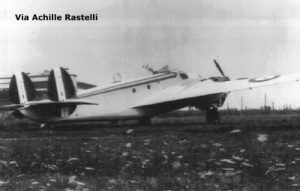
On 11 August 1936, Peru officially confirmed an order for six Ca. 135 with Asso XI R.C. 40 Engines of 815hp, known at the factory as Tipo Peru, at a cost of $525,000 – a lot of money in those times. These were finally test flown, in a striking white and red color scheme peculiar to all six of the Peruvian machines, between August and November 1937, at almost precisely the same time that Argentina finally settled on acquiring the Martin 139WAA, which weren’t delivered until 1938. Concurrently, the CAP also ordered 16 Ca. 310 Libeccio light bomber and reconnaissance aircraft equipped with Piaggio VIIC.16 Engines, but the first of these did not arrive in Peru until May 1939.
From this point on, the fate of these six aircraft – and the often purported acquisition of as many as 32 more later on by Peru (Which did not happen) – becomes murky and punctuated with questions.
Peruvian acquisition of these impressive and, apparently capable aircraft, became almost overnight the subject of intense interest to U.S. defense planners in the Panama Canal area. Contrary to published figures, and even Caproni estimates, U.S. intelligence documents of the time credited the Peruvian Ca. 135s with a maximum range “at normal cruise speed” of 1,125 miles. However, at “Most economical cruise speed” U.S. intelligence credited the aircraft with a range of 1,250 miles at 185mph – almost exactly the distance from Chiclayo to the Pacific locks of the Panama Canal. The potency of these aircraft was not lost upon the proud CAP aircrews selected to train on them and, indeed, while being erected at the Caproni “factory” at Las Palmas, were inspected by none other than the president of Peru himself.
To no one’s surprise, as soon as erection and training were completed, the six Ca. 135s were assigned to Grupo No. 1, XII Escuadrón de Bombardeo as early as 1 July 1940 at (you guessed it) Chiclayo where, by 1 October 1941, they were joined by 10 of the newly arrived Ca. 310s. This assignment has given us the identity of the only known serial number (fuselage codes, actually, unique to the CAP at the time) for a CAP Ca. 135, which was 2-BP-1B. These aircraft were thus poised to threaten not only neighboring Ecuador (with whom hostilities over the border area had escalated to hostilities in the first half of 1941), but also the Panama Canal. Contrary to previous reports, this writer could find no concrete evidence that the Ca, 135s or Ca, 310s took part, in any way, in this conflict (although there is some circumstantial evidence, as will be seen), although the surviving Ca. 111 surely did.
The aircraft must surely have been a source of considerable concern to Ecuador, however, as both Guayaquil and Quito lay within easy flight distance of Chiclayo. So far as can be determined, the aircraft remained the pride of the CAP and received the best care and crews that the service could assign. They were, in every sense of the word, National Assets, and earned the same degree of value as the Peruvian Navy capital ships in terms of the international politics of the region.
The 1941 border conflict with Ecuador has received scant historical attention, and a considerable body of myth, misinformation and guess work regarding the aviation aspect of the war has been repeated over the years since. Oddly enough, the entire incident may very well have been precipitated by a series of bizarre events, some involving aircraft as well as great-power politics.
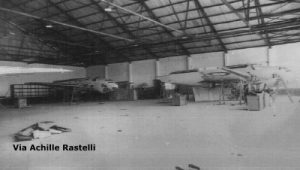
Some readers will recall that German interests had managed to establish a network of efficient, regional and international airlines throughout South America by the end of the 1930s. One of these was Lufthansa Sucursal Perú, which provided a valuable service in the area. The German lines were, in point of fact, closely allied with one another and routinely moved aircraft from one operation to another. By January 1941, Colonel Gilardi of the Peruvian Ministerio de Aviación y Marina is known to have rather pointedly inquired of Herr Krefft of Sucursal Perú why the airline had violated instructions from the ministry relative to “Aircraft transferred from Peru and flown to other countries, to wit: the failure to remove the Peruvian commercial aviation markings from a Junkers Ju-52/3m transport transferred from Peru to SEDTA airline in Ecuador in November 1940” [emphasis author’s]. Krefft reportedly replied that all markings had been removed “As far as was possible” but that “the paint had left marks on the metal surface of the aircraft which were plainly distinguishable after all attempts to erase them.” The discussion between Gilardi and Krefft, allegedly, revealed that, upon the arrival of the Ju-52/3m in Ecuador, a large Ecuadorian flag was painted on the aircraft and that this very aircraft had been flown over both Ecuadorian and Peruvian troops near the border; that it had been identified by the Peruvian as belonging to Ecuador and by the Ecuadorians as belonging to Peru!! Krefft is reported, in a U.S. Office of Naval Intelligence Report dated 10 January 1941, as further stating that this ironic dual recognition of a large, possibly military aircraft, by relatively unschooled troops on the ground, was “Probably due to the two sets of markings carried by the airplane” and stated that there had been no desire or attempt on the part of Sucursal to cause trouble between the two governments.
The same ONI report, however, also contained the startling information, attributed to an informant that “Could not be verified,” that “The Germans were making extensive offers to the Ecuadorians to instigate a war between Ecuador and Peru.” The source further stated that the Germans had promised to give all aid necessary to Ecuador by 20 August 1941 although he could “Not explain the reason for this date.” The Germans allegedly promised Ecuador that they could “Get as much of Peru as they wanted, if they would start a border trouble in the near future.”
In fairness, the same ONI report also recorded that rumors were flying in Lima that it was the United States itself that was fomenting the trouble, as it was thought that the US would “intervene” in any war between the two nations for the purpose of taking control of the Galapagos Islands, which were recognized as vital to the defense of the strategic Panama Canal.
Thus, it would appear that the Sucursal Ju-52/3m (Possibly the one named “Aconcagua”) may have inadvertently (or perhaps no so inadvertently) have precipitated the border clashes that followed, one side believing that the other had sent “military aircraft” bearing their “national markings” over strategic areas.
By August 12, Peru had in fact launched what amounted to a “Blitzkrieg” against southwestern Ecuador, and had seized at least 15 named towns and villages. Cooperation between Peruvian Army ground forces and the CAP were noted by the US Naval Attaché as being “Very good“, and the CAP was reported to have bombed the towns of Santa Rosa, Machala, and Pasajo in particular [this action may have involved the Ca 135s.] CAP bomber/transports [almost certainly the venerable Ca. 111s] landed 12 paratroops in the plaza of Puerto Bolivar itself and took the town completely by surprise. From accounts given to the Naval Attaché, the retreating Ecuadorian forces apparently were much harder on their own people than the advancing Peruvians, who he observed to be sharing their rations with the dumbfounded Ecuadorian citizens.
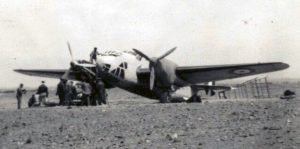
The final air action of the war was apparently on or around 15 September 1941, when CAP aircraft were reported reliably by a U.S. citizen, Dr. William Popence (an employee at the time of the U.S. Department of Agriculture) to have bombed and strafed American property (and the U.S. flag!) at Tenguel, Ecuador. He reported that two CAP aircraft had flown over the region at 10:30 AM local time and dropped eight bombs on Pagua and seven on Tenguel and machine gunned both villages, inflicting casualties of three killed and three or four wounded. At 2:30 PM that same day, Peruvian aircraft again flew over Tenguel and dropped bombs “Obviously aimed at the U.S. office building“, although none hit the building (a man sitting on the veranda was killed by shrapnel, however). After dropping their bombs, the planes strafed both office buildings and residences, including the U.S. flags plainly in evidence at both facilities. One of the aircraft then moved off and gunned the United Fruit Company launch “Pagua”, which was bearing the Ecuadorian flag, however. The entire Ecuadorian Army garrison in Tenguel at the time, according to Dr. Popence, consisted of a Sergeant and six soldiers. A final air attack was reported by another source at 5:00 PM that same day. These attacks, considering the amount of ordnance delivered, may have involved Ca. 135s, but more likely were North American NA-50 fighters. The Observers, unfortunately, did not comment on the types of aircraft involved.
Six months later, as of 6 February 1942, all six Ca. 135s were still very much on strength with the XII Escuadron de Bombardeo at Chiclayo, three with the 14th Division of the unit and three with the 15th Division. It is known that, by this time, spares for both the Ca. 135s and Ca. 310s were beginning to be a problem, due to both the cut off of replacements from Italy due to the war, and the departure of the Italian Mission, and that the CAP was gearing up to accept a massive infusion of new aircraft under the auspices of the Lend-Lease program from the United States. However, what happened next is a complete mystery, and not a shred of information has been found to explain what transpired – or why.
By October 1942, less than seven months after the last U.S. Order of Battle for the CAP, not a single Ca. 135 was reported on the CAP active list. Indeed, not a single further mention was made of the aircraft on any Order of Battle for the remainder of the war, although decreasing numbers of Ca. 310s were reported.
No crashes or operational losses involving Ca. 135s have been identified. No insoluble operational or mechanical problems had been noted on any on any of the pre-October 1942 Order of Battle reports. The airplanes, the pride of the service, simply disappeared, for reasons unknown, completely between February and October 1942.
There has been completely unconfirmed speculation that the aircraft were key pawns in the Ecuadorian agreement to settle the boundary dispute in 1942, contingent upon the complete destruction of the Ca. 135s, which Ecuador viewed as capable of raining undisputed destruction upon her two major population, commerce an governmental centers. However, in view of the complete domination that the Peruvian armed forces enjoyed during the conflict, it is difficult to understand why Peru would be moved to dispose of such valuable assets under such terms. It has also been suggested that the United States, ever vigilant of aircraft capable of reaching the vital locks of the Panama Canal, made the removal of the Ca. 135s from CAP service a condition of the massive infusion of Lend-Lease aircraft that Peru ultimately received.
To date, despite determined efforts, this writer has not discovered the true fate – or reasons – for the sudden disappearance of Latin America’s first truly modern medium bombers. Perhaps one of our readers can shed some light on this perplexing, and rahter old mystery.

